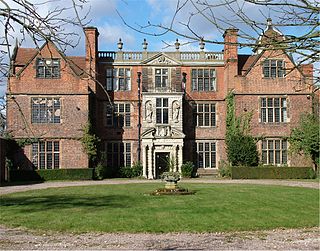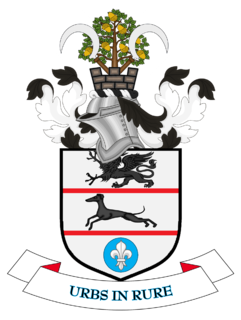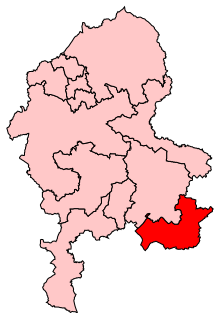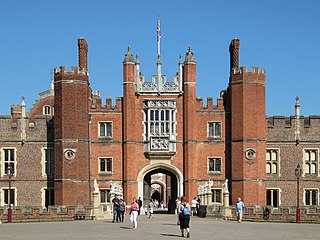
Castle Howard is a stately home in North Yorkshire, England, 15 miles (24 km) north of York. It is a private residence, and has been the home of the Carlisle branch of the Howard family for more than 300 years.
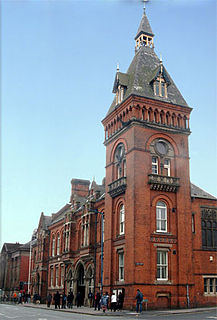
West Bromwich is a large town in the borough of Sandwell, West Midlands, England. Historically part of Staffordshire, it is 6.4 miles (10.3 km) northwest of Birmingham. The population of West Bromwich was 75,405 in 2011.

Ruthin is the county town of Denbighshire in north Wales and a community. Located in the southern part of the Vale of Clwyd, the older part of the town, the castle and St Peter's Square lie on a hill, while many newer parts are in the flood plain of the River Clwyd. This became apparent several times in the late 1990s – flood-control works costing £3 million were completed in autumn 2003. Ruthin is skirted by villages such as Pwllglas and Rhewl. The name comes from the Welsh words rhudd (red) and din (fort), referring to the colour of the red sandstone bedrock, of which the castle was built in 1277–84. The original name was Castell Coch yng Ngwern-fôr. The mill is nearby. Maen Huail is a registered ancient monument attributed to the brother of Gildas and King Arthur, located outside Barclays Bank in St Peter's Square.

Kingston Lacy is a country house and estate near Wimborne Minster, Dorset, England. It was for many years the family seat of the Bankes family who lived nearby at Corfe Castle until its destruction in the English Civil War after its incumbent owners, Sir John Bankes and Dame Mary, had remained loyal to Charles I.
Earl of Bradford is a title that has been created twice, once in the Peerage of England and once in the Peerage of the United Kingdom. It was first created in 1694 for Francis Newport, 2nd Baron Newport. However, all the Newport titles became extinct on the death of the fourth Earl in 1762. The Earldom was revived in 1815 for Orlando Bridgeman, 2nd Baron Bradford. The Bridgeman family had previously succeeded to the Newport estates. The title of the peerage refers to the ancient hundred of Bradford in Shropshire, and not, as might be assumed, to the city of Bradford, Yorkshire.

Wimpole Estate is a large estate containing Wimpole Hall, a country house located within the Parish of Wimpole, Cambridgeshire, England, about 8 1⁄2 miles southwest of Cambridge. The house, begun in 1640, and its 3,000 acres (12 km2) of parkland and farmland are owned by the National Trust and are regularly open to the public. Wimpole is the largest house in Cambridgeshire.

New Hall Manor is a medieval manor house, now used as a hotel, in Sutton Coldfield, West Midlands, England.

Chillington Hall is a Georgian country house near Brewood, Staffordshire, England, four miles northwest of Wolverhampton. It is the residence of the Giffard family. The Grade I listed house was designed by Francis Smith in 1724 and John Soane in 1785. The park and lake were landscaped by Capability Brown.

Weston Park is a country house in Weston-under-Lizard, Staffordshire, England, set in more than 1,000 acres (400 ha) of park landscaped by Capability Brown. The park is located 10 miles (16 km) north-west of Wolverhampton, and 8 miles (13 km) north-east of Telford, close to the border with Shropshire. The 17th-century Hall is a Grade I listed building and several other features of the estate, such as the Orangery and the Stable block, are separately listed as Grade II.

Elvaston Castle is a stately home in Elvaston, Derbyshire, England. The Gothic Revival castle and surrounding parkland is run and owned by Derbyshire County Council as a country park known as, Elvaston Castle Country Park. The country park has 200 acres (0.81 km2) of woodlands, parkland and formal gardens.

St Mary and St Margaret Church, Castle Bromwich is a Grade I listed parish church in the Church of England in Castle Bromwich, Birmingham.

The Great Market Hall or Central Market Hall is the largest and oldest indoor market in Budapest, Hungary. The idea of building such a large market hall arose from the first mayor of Budapest, Károly Kamermayer, and it was his largest investment. He retired in 1896 and participated in the opening ceremony on February 15, 1897.

Chancellors Hotel & Conference Centre, is a Grade II listed mansion in Fallowfield, Manchester, England

The Delaware Historical Society began in 1864 as an effort to preserve documents from the Civil War. Since then, it has expanded into a statewide historical institution with several venues and a major museum in Wilmington and the historic Read House & Gardens in New Castle.
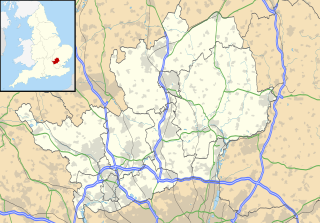
Fanhams Hall is an 18th-century Queen Anne House-style country house in Ware, Hertfordshire in the south east of England. It is a Grade II* listed building which is now operating as a hotel.

Rode Hall, a Georgian country house, is the seat of the Wilbraham family, members of the landed gentry in the parish of Odd Rode, Cheshire, England. The estate, with the original timber-framed manor house, was purchased by the Wilbrahams from the ancient Rode family in 1669. The medieval manor house was replaced between 1700 and 1708 by a brick-built seven-bay building; a second building, with five bays, was built in 1752; the two buildings being joined together in 1800 to form the present Rode Hall.

Rushton Hall in Rushton, Northamptonshire, England, was the ancestral home of the Tresham family from 1438, when William Tresham bought the estate. In the 20th century the house became a private school and it has now been converted to a luxury hotel. The estate is about 227 acres (92 ha) of which 30 acres (12 ha) are formal gardens. The River Ise flows from west to east south of the Hall.
Warner Leisure Hotels is a hospitality company owning 14 country and coastal properties around the UK in North Wales, Somerset, Herefordshire, Berkshire, North Yorkshire, Nottinghamshire, Isle of Wight, Suffolk and Hampshire, with a further under development in Warwickshire

